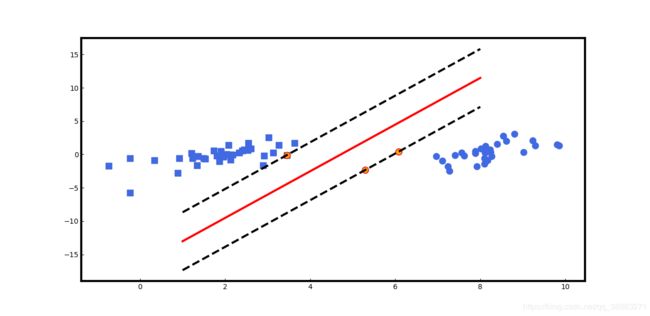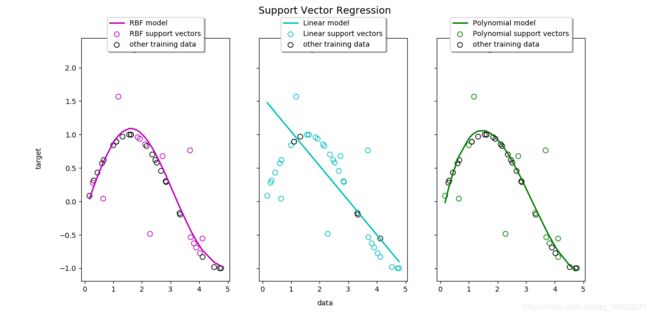利用sklearn实现支持向量机分类和预测模型
-
分类模型:
-
数据集线性可分
from sklearn import svm
from sklearn.model_selection import train_test_split
import numpy as np
from sklearn import metrics
import matplotlib.pyplot as plt
def loadDataSet(filename, delim="\t"):
f = open(filename)
stringArr = [line.strip().split(delim) for line in f.readlines()]
datArr = [list(map(float, line))for line in stringArr]
return np.mat(datArr)
def svc_classification(dataMat):
x = dataMat[:, :2]
y = dataMat[:, 2]
#划分出训练集和测试集,测试集占总样本30%
x_train, x_test, y_train, y_test = train_test_split(x, y, test_size=0.3)
clf = svm.SVC(kernel="linear") #选用线性核函数,通过构造函数SVC生成支持向量机对象
clf.fit(x_train, y_train) #训练数据集
pre_train = clf.predict(x_train) #得到模型关于训练数据集的分类结果
pre_test = clf.predict(x_test) #得到模型关于测试数据集的分类结果
#获取准确度,即正确分类样本占总训练数据集或测试数据集的比例
print("Train Accuracy:%.4f\n" % metrics.accuracy_score(y_train, pre_train))
print("Test Accuracy:%.4f\n" % metrics.accuracy_score(y_test, pre_test))
#只有线性核函数才能获得coef_,即w^Tx+b=0的w平面系数矩阵
return x_train, y_train, clf.support_vectors_, clf.coef_, clf.intercept_
if __name__=="__main__":
dataMat = loadDataSet("testSet.txt")
x_train, y_train, support_vectors, w, b = svc_classification(dataMat)
x = np.linspace(1, 8, 1000)
y = -(w[0, 0] / w[0, 1]) * x - b / w[0, 1] #获取超平面
#获取支持向量机所在平面
y1 = -(w[0, 0] / w[0, 1]) * x - b / w[0, 1] + 1 / w[0, 1]
y_1 = -(w[0, 0] / w[0, 1]) * x - b / w[0, 1] - 1 / w[0, 1]
plt.rcParams['xtick.direction'] = 'in'
plt.rcParams['ytick.direction'] = 'in'
for i in range(len(x_train)):
if y_train[i] == 1:
plt.scatter(x_train[i, 0], x_train[i, 1], marker="o", color="royalblue", s=80)
else:
plt.scatter(x_train[i, 0], x_train[i, 1], marker="s", color="royalblue", s=80)
#标记支持向量机
for j in range(len(support_vectors)):
plt.scatter(support_vectors[j, 0], support_vectors[j, 1], marker="o", edgecolors="r", color="orange", s=80)
plt.plot(x, y, linewidth=3, color="r")
plt.plot(x, y1, linewidth=3, color="k", ls="--")
plt.plot(x, y_1, linewidth=3, color="k", ls="--")
ax = plt.gca()
ax.spines['bottom'].set_linewidth(3)
ax.spines['left'].set_linewidth(3)
ax.spines['right'].set_linewidth(3)
ax.spines['top'].set_linewidth(3)
plt.show()
Train Accuracy:1.0000
Test Accuracy:1.0000
-
数据集非线性可分
此时不能再使用线性核函数,使用线性核函数的错误率会大大增加,应当使用RBF径向基核函数。
from sklearn import svm
from sklearn.model_selection import train_test_split
import numpy as np
from sklearn import metrics
import matplotlib.pyplot as plt
def loadDataSet(filename, delim="\t"):
f = open(filename)
stringArr = [line.strip().split(delim) for line in f.readlines()]
datArr = [list(map(float, line))for line in stringArr]
return np.mat(datArr)
def svc_classification(dataMat):
x = dataMat[:, :2]
y = dataMat[:, 2]
#划分出训练集和测试集,测试集占总样本30%
x_train, x_test, y_train, y_test = train_test_split(x, y, test_size=0.3)
clf = svm.SVC(kernel="rbf") #选用线性核函数,通过构造函数SVC生成支持向量机对象
clf.fit(x_train, y_train) #训练数据集
pre_train = clf.predict(x_train) #得到模型关于训练数据集的分类结果
pre_test = clf.predict(x_test) #得到模型关于测试数据集的分类结果
#获取准确度,即正确分类样本占总训练数据集或测试数据集的比例
print("Train Accuracy:%.4f\n" % metrics.accuracy_score(y_train, pre_train))
print("Test Accuracy:%.4f\n" % metrics.accuracy_score(y_test, pre_test))
#只有线性核函数才能获得coef_,即w^Tx+b=0的w平面系数矩阵
return x_train, y_train, clf.support_vectors_
if __name__=="__main__":
dataMat = loadDataSet("testSetRBF2.txt")
x_train, y_train, support_vectors = svc_classification(dataMat)
plt.rcParams['xtick.direction'] = 'in'
plt.rcParams['ytick.direction'] = 'in'
for i in range(len(x_train)):
if y_train[i] == 1:
plt.scatter(x_train[i, 0], x_train[i, 1], marker="^", color="royalblue", s=80)
else:
plt.scatter(x_train[i, 0], x_train[i, 1], marker="s", color="royalblue", s=80)
#标记支持向量机
for j in range(len(support_vectors)):
plt.scatter(support_vectors[j, 0], support_vectors[j, 1], marker="o", edgecolors="r", color="orange", s=30)
ax = plt.gca()
ax.spines['bottom'].set_linewidth(3)
ax.spines['left'].set_linewidth(3)
ax.spines['right'].set_linewidth(3)
ax.spines['top'].set_linewidth(3)
plt.show()
Train Accuracy:0.9857
Test Accuracy:0.9667
-
利用10折交叉验证进行数据集的训练与测试
from sklearn import svm
from sklearn.model_selection import KFold
import numpy as np
from sklearn import metrics
def loadDataSet(filename, delim="\t"):
f = open(filename)
stringArr = [line.strip().split(delim) for line in f.readlines()]
datArr = [list(map(float, line))for line in stringArr]
return np.mat(datArr)
def svc_classification(dataMat):
iter = 1
x = dataMat[:, :2]
y = dataMat[:, 2]
clf = svm.SVC(kernel="rbf")
kf = KFold(n_splits=10)
for train, test in kf.split(dataMat):
clf.fit(x[train, :], y[train, :]) #训练数据集
pre_train = clf.predict(x[train, :]) #得到模型关于训练数据集的分类结果
pre_test = clf.predict(x[test, :]) #得到模型关于测试数据集的分类结果
#获取准确度,即正确分类样本占总训练数据集或测试数据集的比例
print("The "+str(iter)+"th cross validation:")
print("Train Accuracy:%.4f" % metrics.accuracy_score(y[train, :], pre_train) + \
"\tTest Accuracy:%.4f\n" % metrics.accuracy_score(y[test, :], pre_test))
iter = iter + 1
if __name__=="__main__":
dataMat = loadDataSet("testSetRBF2.txt")
svc_classification(dataMat)
The 1th cross validation:
Train Accuracy:0.9556 Test Accuracy:1.0000
The 2th cross validation:
Train Accuracy:0.9778 Test Accuracy:1.0000
The 3th cross validation:
Train Accuracy:0.9778 Test Accuracy:1.0000
The 4th cross validation:
Train Accuracy:0.9667 Test Accuracy:0.9000
The 5th cross validation:
Train Accuracy:0.9667 Test Accuracy:0.9000
The 6th cross validation:
Train Accuracy:0.9667 Test Accuracy:0.9000
The 7th cross validation:
Train Accuracy:0.9444 Test Accuracy:1.0000
The 8th cross validation:
Train Accuracy:0.9778 Test Accuracy:1.0000
The 9th cross validation:
Train Accuracy:0.9778 Test Accuracy:0.8000
The 10th cross validation:
Train Accuracy:0.9667 Test Accuracy:0.9000
-
预测模型:
from sklearn import svm
import numpy as np
import matplotlib.pyplot as plt
X = np.sort(5 * np.random.rand(40, 1), axis=0)
y = np.sin(X).ravel()
# 从第一个y开始每5个步长添加噪声数值
y[::5] += 3 * (0.5 - np.random.rand(8))
# epsilon为容忍度,C为正则化惩罚系数,即当预测值与真实值之间的误差大于容忍度时进行L2正则化
# C越大惩罚力度越大,得到的拟合结果越好
# degree为多项式核函数的多项式阶数
svr_rbf = svm.SVR(kernel="rbf", C=100, gamma=0.1, epsilon=.1)
svr_lin = svm.SVR(kernel="linear", C=100, gamma="auto")
svr_poly = svm.SVR(kernel="poly", C=100, gamma="auto", degree=3,\
epsilon=.1, coef0=1)
lw = 2 # 线宽
svrs = [svr_rbf, svr_lin, svr_poly]
kernel_label = ['RBF', 'Linear', 'Polynomial']
model_color = ['m', 'c', 'g']
# sharey参数为是否共享纵轴,默认为False
# subplots返回画布(fig)和画布区域(axes)
fig, axes = plt.subplots(nrows=1, ncols=3, figsize=(15, 10), sharey=True)
for ix, svr in enumerate(svrs):
axes[ix].plot(X, svr.fit(X, y).predict(X), color=model_color[ix], lw=lw,
label='{} model'.format(kernel_label[ix]))
# support_是支持向量机的索引
axes[ix].scatter(X[svr.support_], y[svr.support_], facecolor="none",
edgecolor=model_color[ix], s=50,
label='{} support vectors'.format(kernel_label[ix]))
# 寻找非支持向量机的数据集
axes[ix].scatter(X[np.setdiff1d(np.arange(len(X)), svr.support_)],
y[np.setdiff1d(np.arange(len(X)), svr.support_)],
facecolor="none", edgecolor="k", s=50,
label='other training data')
axes[ix].legend(loc='upper center', bbox_to_anchor=(0.5, 1.1),
ncol=1, fancybox=True, shadow=True)
fig.text(0.5, 0.04, 'data', ha='center', va='center')
fig.text(0.06, 0.5, 'target', ha='center', va='center', rotation='vertical')
fig.suptitle("Support Vector Regression", fontsize=14)
plt.show()


